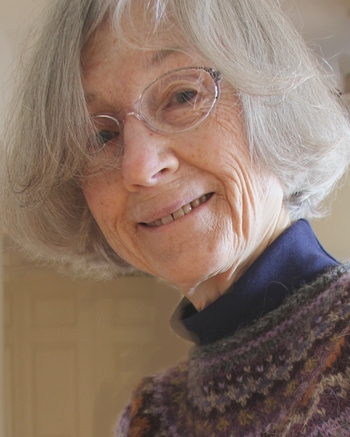
Awake at Midnight welcomes Mary Downing Hahn, author of more than twenty books for children and an Edgar Award winner for Closed for the Season in 2010, (as well as the Scott O’Dell Award for Historical Fiction for Stepping on the Cracks, and countless others). Her ghost stories are classics recognized on every Halloween reading list. She joins us today to discuss her latest publication, Took and writing scary stories for kids!
Awake at Midnight:
Your latest publication, Took, is a bit more frightening than many of your ghostly tales; there isn’t any question of whether the conjure woman is imaginary or misunderstood– she is real and filled with malice. She takes a child and there is nothing her brother or her parents or the entire town can do about it. Were you worried that some of the imagery might be too scary for elementary school children? How do you tell when it’s time to dial down the intensity?
Mary Downing Hahn:
Usually the story tells itself and I write it down as it comes to me. Every now and then, I pause and ask myself if the story is too dark or too frightening. I actually worry about the images my mind produces, but I think today’s kids aren’t as easily frightened as the kids of my generation. For instance, I doubt today’s seven year old would be so scared watching Walt Disney’s Snow White that she’d crawl under her seat in the movie theater (as I did) to hide from the witch. The point that I won’t go beyond is violence and bloodshed– the spattered brains and guts genre, as I call it. In other words, the witch is real but I’m not going to allow her to kill anyone.
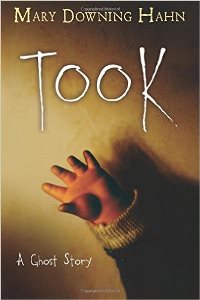
Bloody Bones is a staple of back-woods American folklore from the Appalachian Mountain region. How did that legend inspire the story?
Sometimes I’m not really sure why a character enters a story. It’s as if Raw Head and Bloody Bones simply stepped out of the woods and joined the witch. I let him stay — she needed a companion to share her dark thoughts and plans.
Rawhead and Bloody Bones
Steals naughty children from their homes,
Takes them to his dirty den,
And they are never seen again.
Did reading scary stories as a kid influence your becoming a writer of so many supernatural novels? What stories do you remember that stick with you?
When I was a kid, I was a classic scaredy-cat, terrified of the long-armed witch under my bed, the wolf behind the door, and the monster creeping up the steps. I liked happy family stories (e.g. the Moffat series), heroic dog stories beginning with Lassie, Come Home, which I read five times when I was ten or eleven, adventure stories like Treasure Island, Tom Sawyer, and Kidnapped, orphan stories like The Secret Garden and Anne of Green Gables. I read with a love and passion for books which I still have today. My friends and I often acted out what we read and sometimes got in trouble — we loved mischief, in books and in real life.
The story that frightened me the most when I was still too young to read was “Hansel and Gretel”, which was included in a collection of stories put together by Watty Piper. I’d let my mother begin reading, but as soon as the children found the wicked witch’s cottage, I made her stop. It wasn’t until I was old enough to read the story myself that I learned it had a happy ending for Hansel and Gretel but not for the witch. I like to think knowing how to read gave me power over the story. I could go on or stop whenever I liked.
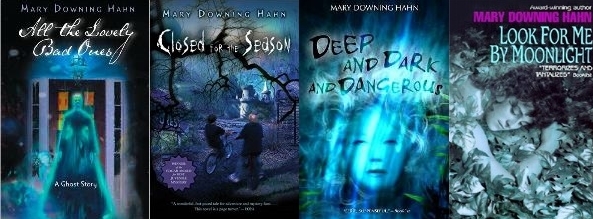
Were there certain books or authors that influenced you as a writer?
I’m sure it’s a cliché, but I’d have to say Catcher in the Rye was a major influence. I read it for the first time when I was sixteen. A friend of mine came running up to me, waving the book and screaming, “You have to read this, Mary, it’s the best book I’ve ever read!” And it was. For the first time, I met a character who thought, acted and talked like a teenager. Holden Caulfield was real life. I knew him like I knew myself. By the time I was in college and taking creative writing courses, I wanted to be the J.D. Salinger of my generation.
You might think it odd that I refer to Salinger who never had any truck with ghosts as far as I know, but I’ve written many non-ghost stories. In both ghost and non-ghost stories, I strive for Salinger’s easy flow of realistic dialogue. Note I say strive. He’s not an easy act to follow.
Your titles always warn readers when they are “A Ghost Story”. It adds a great touch, like the beginning of Lights Out or a William Castle movie when they urged the faint of heart to leave or turn off their radios now, while also making a promise to readers. How would you define your scary stories– do you consider them “horror” or just supernatural fantasy? What promise does a ghost story offer that your average mid-grade mystery might not?
I hate “horror stories” and equate them with violence and grisly details: the Lovecraft school vs. the M.R. James school or gruesome terror vs creeping dread. I definitely think of my books as supernatural fantasy of the creeping dread variety.
A middle grade mystery is suspenseful and so is a ghost story, but I think a good ghost story contains psychological elements not necessarily found in mysteries. In my ghost stories, I try to provide a psychological link between a human and a ghost. For instance, I could have written Wait Till Helen Comes as a realistic account of a troubled child doing her best to unravel the marriage of her father to Molly and Michael’s mother. I let Helen enter the story to reveal the secret she and Heather share about fire. In a way, the haunting was a shortcut to both Heather’s and Helen’s redemption.
“Lights Out brings you stories of the supernatural and the super-normal, dramatizing the fantasies and the mysteries of the unknown. We tell you this frankly, so if you wish to avoid the excitement and tension of these imaginative plays, we urge you calmly, but sincerely, to turn off your radio now.”
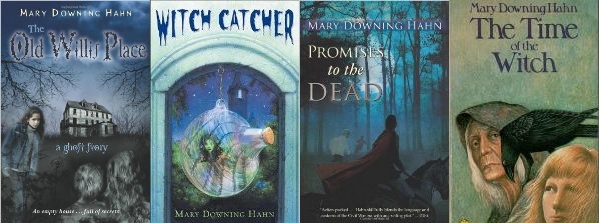
Some libraries challenged or banned Wait Till Helen Comes because of its mention of suicide and The Dead Man in Indian Creek because it deals with drugs, but both stories mark the lines where scary things can cross into real life. Why is the ability to tell these sometimes intense ghost stories to kids so important?
Ah, you’ve got me there. Maybe it’s because children often undergo experiences they don’t understand– something may happen to them or to someone they know. They might wonder what they’d do if something bad entered their lives. Maybe reading about a child who triumphs over a bad experience helps them somehow. Or then maybe it simply entertains them to be taken out of their safe world and given a scare. They’re safe in their own home, they can close the book whenever they like, they can turn on the light if they want to.
Your recent novel for Young Adults, Mister Death’s Blue-Eyed Girls was based on a childhood event, when two schoolmates were shot and their killer was never identified. That’s a pretty life-shaking experience. Did you find that it caused you to question your faith the way it does Nora? How you think about death differently now than you did then?
Mister Death’s Blue-Eyed Girls was the most difficult novel I’ve ever written. It scared me to reveal so much of my teenage self, including my religious doubts, but I’d wanted to write about the murders for many years. After James Cross Giblin accepted my first novel, The Sara Summer, in 1978, I told him about my attempts to write a teen novel about the murders. He was very interested and encouraged me to keep trying. I began the novel many times, but always abandoned it. Every now and then, Jim would ask about it, but I wrote many novels before I finally sat down and finished Mister Death’s Blue-Eyed Girls. It took well over a year. One of my major fears was offending someone who knew or was related to the girls. So far that fear hasn’t materialized. When I wrote the last revision, I was exhausted. I thought I’d never write another book– “Blue-Eyed Girls” had drained me of my writing energy.
As for death — I’m more angry about it than scared. I enjoy writing because I always know what happens next. Then along comes death and there’s no next. There’s no and-then-what-happened.
Just an aside — I believe Mister Death’s Blue-Eyed Girls is the best novel I’ve ever written or ever will write, but its sales have been very disappointing. Perhaps I should have listened to the inner voice that warned me not to publish the novel.
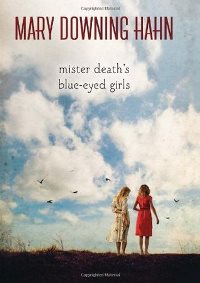
We see bits of the memory in other novels, too, like The Dead Man in Indian Creek. Do you think that writing stories that deal with scary things helps you to cope with your own personal fears and become a braver person, or is it just a release, a catharsis?
I once hoped writing about scary things might be cathartic but I haven’t found that to be true. I have just as many fears as I’ve always had– though not of the witch-under-the-bed variety.
You’ve mentioned that your grandmother used to frighten you with her superstitious beliefs; that she showed up in the traits of many of your characters. Can you tell us more about her ideas and how she affected your childhood? How did you end up in her care?
My mother’s father died when she was thirteen, and her mother more or less left her to live with relatives of her father, which suited Mom just fine– they were more fun to be around than her mother. When my mother and father married, guess who moved in with them? Although my grandmother came from a large German family, she had antagonized most of them. Since she had nowhere else to go, she told my mother it was her duty to take her in.
To this day, I do not understand how my parents’ marriage survived Nanny’s presence. She took a strong dislike to my father and did her best to drive him out of the house.
My mother taught school and left me in Nanny’s care. Suffice it to say, it was like being babysat by the witch under the bed. It’s no wonder I was terrified of “Snow White” and “Hansel and Gretel.”
Nanny made me unhappy in many ways, but probably the worst thing she did involved the birth of my sister. It was January in 1943, and I was five years old. We didn’t have a car —it was during WWII— and my mother was taken to the hospital in an ambulance. Our house was on a hill. In the winter, we could look down through the bare trees at the traffic on U.S. Route One. We’d stand in the dark living room, Nanny and I, and she’d point at the headlights and say, “Your mother isn’t in any of those cars. She’s never coming home. She’s going to die in the hospital. You won’t see her again.”
I never questioned her or told my father. Then came the day the ambulance brought my mother and baby sister home. They were carried into the house on a stretcher. Believing my mother and the baby were both dead, I hid under the big old fashioned gas range in the kitchen. Nanny called me to come and see my mother, but I stayed where I was. I didn’t want to see her, not if she was dead.
Finally someone, maybe Nanny, maybe my father dragged me out and brought me into the bedroom. There was my mother lying in bed with the baby, both very much alive. My parents believed Nanny when she said I hadn’t come to see my mother because I was too jealous of the baby to enter the bedroom.
It was years before this misunderstanding was cleared up.
The book most closely reflecting my relationship with my grandmother is Daphne’s Book; but every cranky, unpleasant, scary old person in my novels has Nanny to thank for their existence.
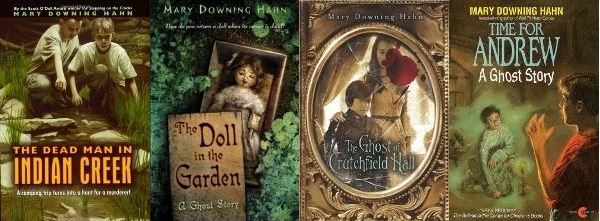
Wait Till Helen Comes was considered pretty scary when it came out in 1986 (and still is). With the advent of mainstream television shows like The Walking Dead and American Horror Story, Do you think today’s middle-grade audience and their expectations are different than the audiences of the ‘80s?
I’m sure today’s kids have a greater stomach for horror than I ever had. I’ve never watched either The Walking Dead or American Horror Story. I haven’t read many of Steven King’s novels either, though I have watched some of his movies.
I once visited a middle school book discussion group and was amazed by the horror novels they read with relish. One of them said he liked it when the writer put in funny stuff like when the hero discovered a head in the bread box. Trust me, no one will find a head in a bread box in any of my stories– maybe a skull, but not a freshly severed head. Why is it that skulls are not as scary? Maybe because the death took place a long time ago and is thus at a distance?
At one point you said you didn’t feel like writing any more ghost stories, but then you turned around and gave us one of your most frightening yet! Why the change of heart?
As I said in the beginning, stories come to me and must be told in their own way. I truly wish I wrote funny stories or deeply meaningful novels about kids who find dogs in super markets or droll talking animals or picture books about mischievous kittens or puppies or little lost rabbits. Maybe someday the muse will send a story of that sort to me by accident.
Do you ever feel like you’re trying to top your last book in terms of it being more frightening?
I think it’s more like keeping the stories going along at about the same level, scary enough for kids to enjoy a good shiver but not scary enough to keep them up after midnight! I sometimes worry my imagination is just too dark but once the story gets its teeth into me it won’t let go until I’ve written it down.
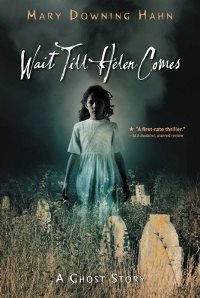
It was announced that the long-awaited movie version of Wait Till Helen Comes will be released this year! How much input did you have in the movie?
I was offered an opportunity to work on the script but turned it down. For one thing, as much as I love movies, I know nothing about formatting a script — it’s a totally different way of writing. I was also working on other novels and didn’t want to go back to a book I’d written years ago, my first ghost story ever. Plus, Victoria Sanchez, the wonderful and dedicated young woman behind the movie, loved the novel when she was a kid and wanted to stay true to the story. She’s made some changes and added scenes, but I have no objections– what works in a book doesn’t always transfer to film and vice versa. I haven’t read the script because I want to be surprised by the film.
Do I understand you might be appearing in it, like Hitchcock’s cameos?
I mentioned it to Victoria years ago, never really thinking it would happen. When the film finally went into production, Victoria asked me to come to Winnipeg and play the role of Mrs. Williams, the librarian. I truly enjoyed the experience. I loved meeting the cast, especially Isabelle Nerisse who mesmerized me in the movie Mama. I was thrilled she’d been chosen to play Heather.
It was amazing to be part of a movie and to see how a film is put together. I had never realized how much work goes into a production. My scene is maybe five minutes max, but it took a whole day to shoot it. I tell people if I’d known I’d play the librarian, I would have written her into more scenes. Everywhere Michael and Molly went, Mrs. Williams would leap out from behind a tree or a building and say, “Wait, I just found something else you should know!”
What are you working on writing now? Are there any new books we should be looking for on the racks soon?
My next book is finished and will be published in the spring of 2017. It’s — hold on, this will surprise you — a very scary ghost story. One for Sorrow is set in a town near Baltimore in 1918, the year World War I ended and the Spanish Influenza began. When a girl no one likes dies of the flu, her ghost returns to seek revenge.
I’ve also finished a fairy tale called “Guest” which differs in style and content from anything I’ve ever written. I love fairy tales, and. when I took a walking tour of Ireland last summer, I was struck by the beauty and enchantment of the land. Here we were, a group of older woman, trekking through rain and bogs and boulders and mossy forests, expecting to see a fairy pop out of the ferns or from behind a boulder.
In writing “Guest,” I re-lived my Irish rambles and drew upon Celtic legends. In my story, Mollie O’Manny’s brother Thomas is taken by The Kinde Folke, and a changeling is left in his place. Everyone blames Mollie for not preventing the swap. Her home life is destroyed by Guest, the name they give the changeling, and Mollie takes it upon herself to find the Kinde Folke and demand they return Thomas and take back Guest. I had a wonderful time writing the story but I haven’t yet heard my editor’s opinion.
I’m currently working on yet another ghost story called “The Girl in the Locked Room.” I’ve written about seventy pages so far and am excited to discover where the characters lead me.
One of these days, I hope my muse will send me a happy story about a talking cat who has hilarious adventures.
Related Posts:

As an adult, I discovered Mary Downing Hahn when accompanying my bookseller (used and scarce) husband and picked up The Old Willis Place. I was hooked, and loved every one I could find and read…sadly she writes faster than I can collect, but the ones I have are often read more than once. Her command of suspense that reaches but does not cross from scary into horror. Every one is a gem. My Appalachian heritage included Raw Head and Bloody Bones when I was pre school and wanted to go out of the house and explore the neighbor’s barn in the moonlight. Didn’t happen, once I heard my grandmother utter those words in a spooky voice. I decided to wait until morning, and fled to my bed. LOL
I love Mary Downing Hahn’s books with out without ghosts, but I really do love a good ghost story. Looking forward to reading TOOK. I’ll be keeping an eye out for the grandmother!